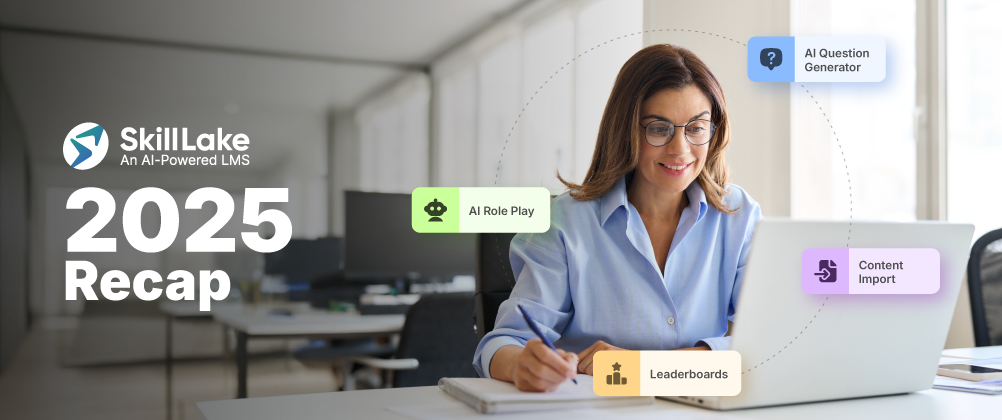
The IT LMS is revolutionizing the way organizations approach employee training and development. Investing in a Learning Management System (LMS) has become essential for companies. It keeps their teams updated with the latest technologies and industry practices. With a focus on efficiency and accessibility, an LMS offers a structured platform for continuous learning.
At a global level, the LMS market is expected to reach USD 40.95 billion by 2029 at a 14.2% CAGR. The future of LMS for software companies holds exciting possibilities, particularly with advancements in Artificial Intelligence (AI) and personalized learning pathways, which in turn are reshaping employees’ engagement with required content and business practices.
Importance of LMS in the Software Industry
Constant learning is vital for staying competitive in today’s software industry. LMS for software companies offers a centralized system for training. It enables businesses to deliver consistent, up-to-date learning across teams. IT LMS assists software companies in streamlining training, reducing operational costs, and enhancing employee performance. It also provides easy access to relevant resources and courses anytime, anywhere.
The Role of AI in Modern LMS
Indeed, LMS for software companies are facing an incredible evolution, particularly with the integration of Artificial Intelligence (AI). Of course, it is not limited to tracking progress and managing course materials.
Because LMS platforms are advancing personalized, interactive, and intelligent learning experiences. AI in LMSs is unlocking new levels of engagement, efficiency, and accessibility. It further sets a new standard for digital learning.
AI-enabled LMSs like Skill Lake can enhance learning experiences by enabling users to remain updated with new technologies and trends in the field. They can also recommend relevant content that aligns with the learning journey and effectively sharpens skills.
With the potential for continuous improvement, AI ensures that the learning process evolves alongside employee needs and technological advancements. It makes IT LMS an invaluable tool for software companies.
How LMS Enhances Personalization in Learning for Software Companies
The LMS market is expected to reach approximately $30 billion (29.9 billion) by 2025, with a yearly growth rate of 21.1%. LMSs are undoubtedly now the training choice for IT companies. This is mainly due to their personalized learning experiences, which are free of hassle or effort. Modern LMSs like Skill Lake allow users to choose from various learning modes, making training convenient and knowledge retention rates high.
Professionals with an IT background have less time to read through heavy materials. However, these are the skills that are required to be hampered from time to time. That’s why modern LMSs are built to enhance convenience, engagement, and interactiveness. Skill Lake is an LMS that enriches the learning journey with synchronous, asynchronous learning modes, instructor-led and self-paced learning, and mobile learning abilities. Enabling multiple content delivery modes like videos, webinars, AR/VR content, and gamification spikes knowledge grasping levels, enriching learners’ learning journey experience.
Benefits of an LMS for the IT Industry
Easy Identification Of Skill Gaps
The IT industry is fast-growing and highly competitive. To stay ahead of the market, companies need to ensure they have the right skills and a future-ready workforce. This requires continuous monitoring of performances and identification of skill gaps. A modern LMS with continuous monitoring and competency mapping features can help organizations quickly identify and rectify skill gaps with specified training courses. An AI-powered LMS makes the process even more seamless by enabling easy content creation that targets a specific skill development or training objective.
Personalized Learning
IT professionals need highly motivating and engaging learning experiences to keep them hooked on the learning journey. An IT LMS built with AI features can easily recommend course materials and content that aligns with the user’s learning preferences, job roles, career paths, and skill development needs, keeping them active on their learning path.
Employee Engagement
Data published by CertifyMe.net revealed that 72% of companies trust that e-learning helps them stay updated and remain competitive. LMS for software companies provides a dynamic, interactive experience that engages employees.
Modern LMS like Skill Lake feature learning journals, interactive feeds, gamification, course credits, and learning bytes that keep learners on track in their learning journey. AR/VR and gamification learning elements make learning more exciting and interactive, enhancing learner engagement and experience.
Gamification Features
Gamification in an LMS includes game mechanics such as points, leaderboards, and achievements. These mechanics help boost employees’ motivation. IT companies can encourage continuous engagement through competition and rewards.
Employees track their progress, earn badges, and set goals as they complete tasks. Gamification also increases retention rates and makes learning more enjoyable. It drives higher participation in training programs and enhances the learning journey.
Emerging Trends in LMS for 2025
Microlearning
Microlearning delivers content in focused, small chunks that employees can easily use. This makes learning more manageable and improves knowledge retention.
It makes short and engaging training sessions accessible. It enables employees to learn and improve their skills at their own pace. Microlearning is very suitable for mastering dedicated skills without overwhelming learners.
Mobile-First Learning
According to a report, employee performance can increase by 15 to 25% if you enable them to learn at their convenience. Learning through mobile devices enables employees to access training materials anywhere, anytime.
This makes learning more convenient for remote employees. The mobile-first design also makes learning more dynamic and increases learner engagement.
AI-Powered Mentorship
AI-powered mentorship is revolutionizing employee development. Using AI-based LMS, employees get mentors based on their learning needs. LMS for software companies makes mentorship more accessible and scalable. Personalized, real-time feedback from AI-driven LMS helps employees improve and stay engaged.
Blockchain for Enhanced Security
LMS for software companies integrates blockchain to enhance transparency and trust. Blockchain technology is transforming LMS security.
Using decentralized records, blockchain ensures everything is verifiable, secure, and tamper-proof. This simplifies the verification process and removes the risk of fraudulent credentials.
Conclusion
Integrating AI and personalized learning in LMS is transforming learning in organizations. AI enables responsive, adaptive training that suits individual learning styles, enhancing engagement. Also, it offers continuous improvement in employees’ learning. Meanwhile, personalized content enables employees to meet their career goals. It motivates and makes the workforce competitive in the organization.
The global LMS market was valued at USD 24,879.82 million in 2023 and is estimated to reach USD 1,21,789.87 million by 2032, with an increasing CAGR of 19.30% from 2022 to 2032. LMS for software companies focuses on promoting collaboration and strengthening relationships.
Peer learning opportunities and enhanced communication create a sense of strong community. Top IT LMSs like Skill Lake can increase retention rates, job satisfaction, and success.
Skill Lake is built to transform training approaches with AI and personalization. It helps learners receive relevant content based on their skills and learning patterns. Several learning modes and gamification help employees stay engaged and motivated. This results in improved learning outcomes and continuous skill development.
Get started today and revolutionize your training methods with Skill Lake. Contact us now or request a free demo!


Aarathy Jayakrishnan
Aarathy is an e-learning professional and enthusiast with a keen understanding of learning and development concepts. She writes insightful content, unraveling the possibilities that e-learning holds, and strives to make education open for all.